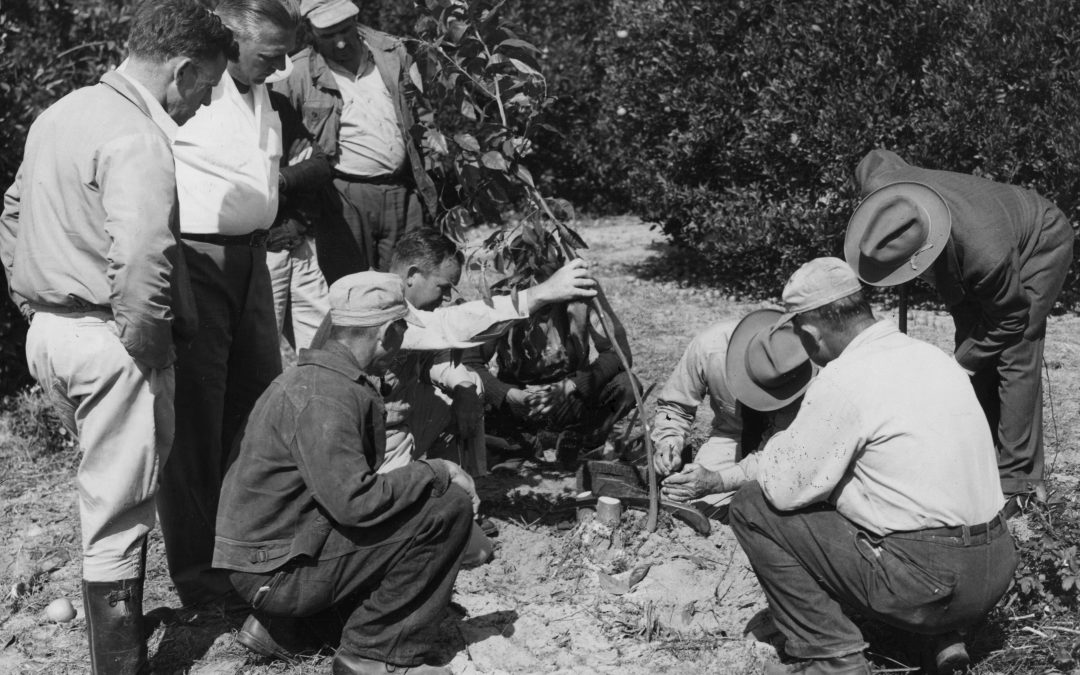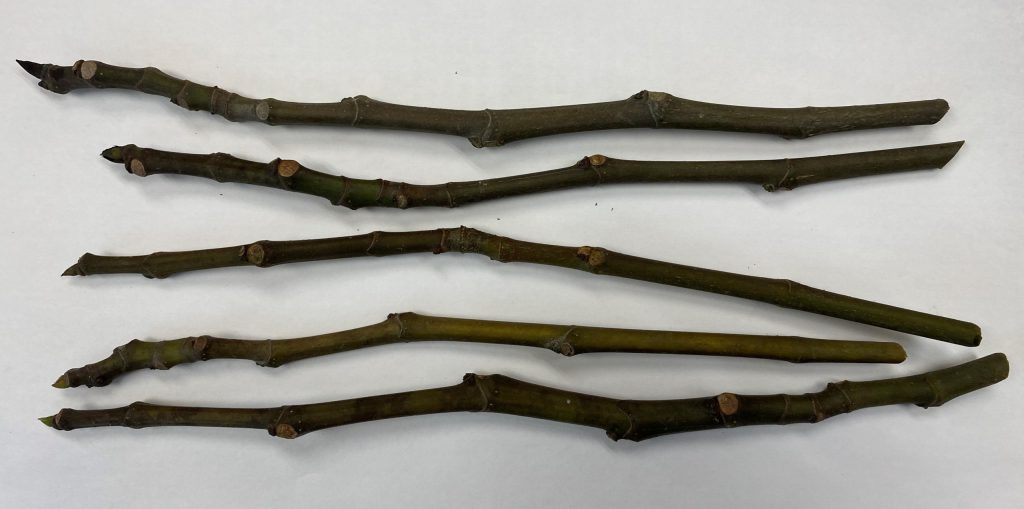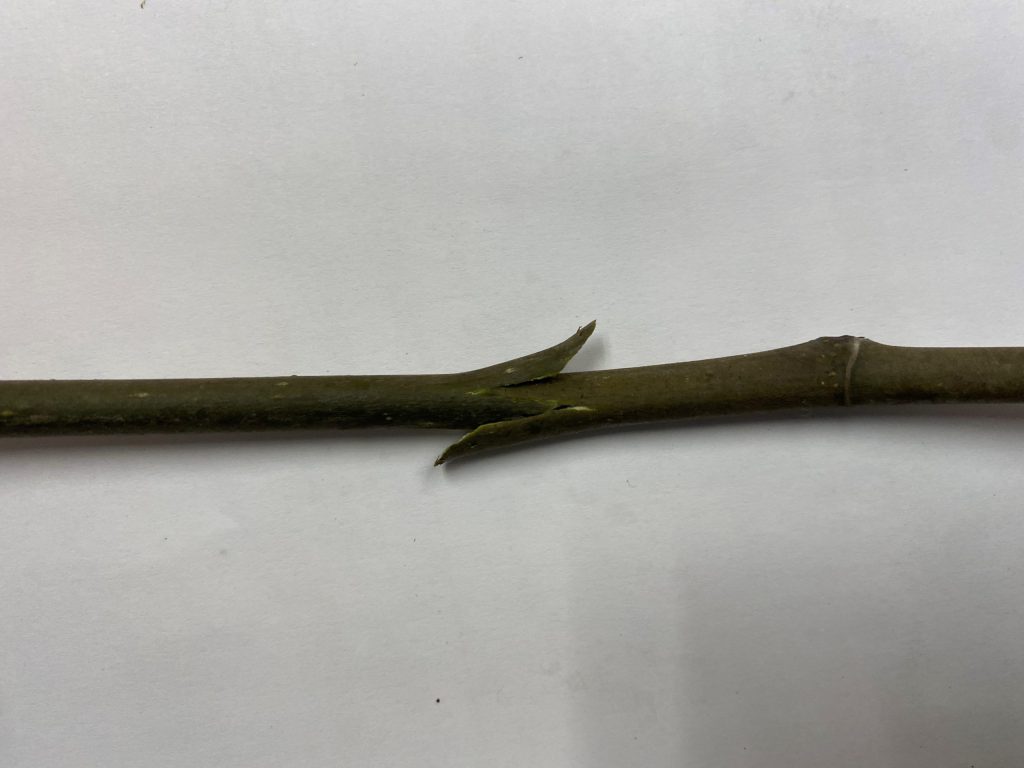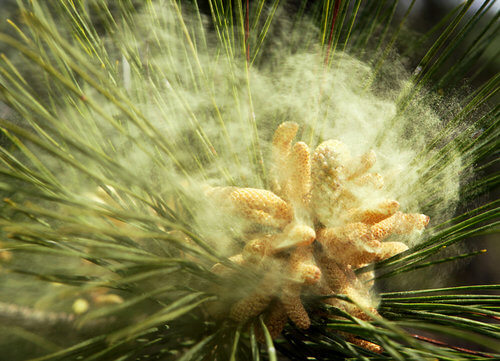
by Matt Lollar | Feb 18, 2021
It’s mid-February, cloudy, and cold. It’s time to get outside and take cuttings for fruit and nut tree grafting. The cuttings that are grafted onto other trees are called scions. The trees or saplings that the scions are grafted to are called rootstocks. Grafting should be done when plants start to show signs of new growth, but for best results, scion wood should be cut in February and early March.
Scion Selection
Straight and smooth wood with the diameter of a pencil should be selected for scions. Water sprouts that grow upright in the center of trees work well for scion wood. Scions should be cut to 12-18″ for storage. They should only need two to three buds each.

Scions ready for grafting. Photo Credit: Matt Lollar, University of Florida/IFAS Extension – Santa Rosa County
Scion Storage
Scions should be cut during the dormant season and refrigerated at 35-40°F until the time of grafting. If cuttings are taken in the field or far from home, then simply place them in a cooler with an ice pack until they can be refrigerated. Cuttings should be placed in a produce or zip top bag along with some damp paper towels or sphagnum moss.
Grafting
It is better to be late than early when it comes to grafting. Some years it’s still cold on Easter Sunday. Generally, mid-March to early April is a good time to graft in North Florida. Whip and tongue or bench grafting are most commonly used for fruit and nut trees. This type of graft is accomplished by cutting a diagonal cut across both the scion and the rootstock, followed by a vertical cut parallel to the grain of the wood. For more information on this type of graft please visit the Grafting Fruit Trees in the Home Orchard from the University of New Hampshire Extension.

A bench graft union. Photo Credit: Matt Lollar, University of Florida/IFAS Extension – Santa Rosa County
Achieving good bench graft unions takes skill and some practice. Some people have better success using a four-flap or banana graft technique. This type of graft is accomplished by stripping most of the bark and cambium layer from a 1.5″ section of the base of the scion and by folding the back and removing a 1.5″ section of wood from the top of the rootstock. A guide to this type of graft can be found on the Texas A&M factsheet “The Four-Flap Graft”.
Grafting is a gardening skill that can add a lot of diversity to a garden. With a little practice, patience, and knowledge any gardener can have success with grafting.

by Taylor Vandiver | Mar 24, 2015
It’s that time of year again, that time when your car changes color like a chameleon in order to mimic the surrounding landscape. Anything that stands still long enough will become coated with a light green to yellow dust. What is this dust you might ask? What you are seeing is pollen, a sure sign that spring has arrived and allergy season is here! The pollen that can be seen is from pine trees and is not a major contributor to allergies, but the invisible pollen from oak trees and other plants can wreak havoc on sinuses. And while you may be cursing the trees for causing your eyes to water and coating your car, it’s important to remember that plants need pollen in order to reproduce.

Pollen disseminating from a pine tree anther. Picture courtesy of http://supermanherbs.com/megadose-pine-pollen/
Pollen is disseminated from blooming trees and plants. The process of pollination develops new plant seeds. Pollen is dry and light, enabling it to float through the wind and travel several miles. Plants that depend on wind for dispersal have to produce massive amounts of pollen since only a small amount will actually result in seed production. Plants pollinated by insects don’t have to produce as much pollen because of the efficiency of the insects in distributing the pollen. Changes in the weather directly influence the amount of pollen and how it will affect allergy sufferers. Rain dampens pollen and reduces its ability to flow through the air. A freeze can also slow down a tree’s rate of producing pollen. Windy and warm weather can increase pollen amounts.
A Leon County allergy and asthma specialist stated that roughly 40 percent of the population suffers from pollen allergies. The best thing you can do if you are part of this 40 percent is to reduce your exposure to pollen. Here are a few ways you can keep your allergies at bay:
- Dry clothes in an automatic dryer rather than hanging them outside to avoid pollen collecting on clothing and being carried indoors.
- Consider limiting outdoor activities during the pollen season (Florida trees often release pollen from January to June).
- Stay inside during peak pollen times (from 10 a.m. to 4 p.m.).
- Restrict outdoor activities during days with high winds and low humidity.
- Shower after spending time outdoors to remove pollen from hair and skin.
- Use air filters and clean regularly, or run an air conditioner and change the air filter frequently.
- Wear a dust mask when mowing the lawn, gardening, or raking leaves.
If you would like to know what trees are producing pollen in your area at certain times of the year you can visit this website http://www.pollenlibrary.com/State/Florida/. As always, feel free to contact your local Extension Office for more information.




